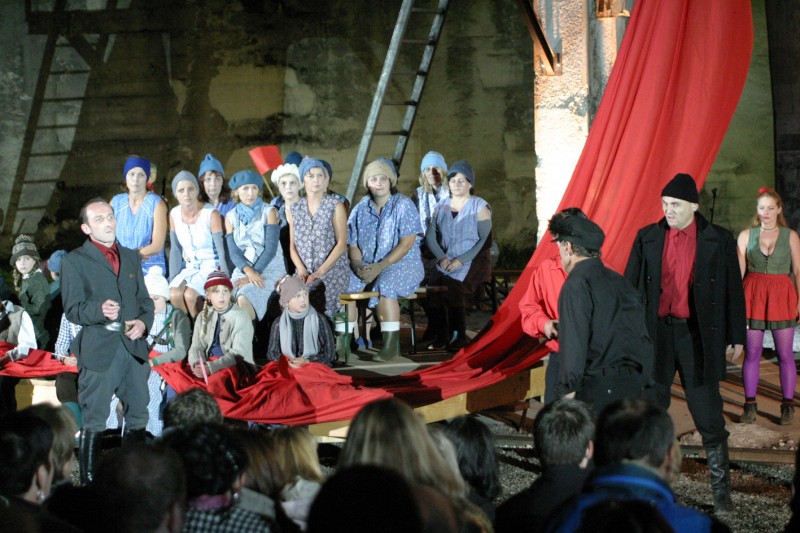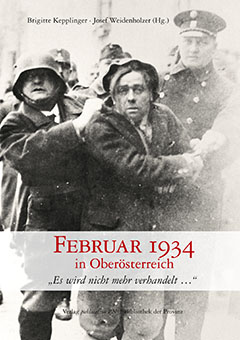
04 Oct “Hunt oder der totale Februar”
In February 1934, Austrians shot at Austrians. Social Democrats against Christian Socialists, Schutzbund against Heimwehr. Democracy against the corporative state. Despair against contempt. Dead on both sides! The fighting in Hausruck was particularly fierce.
The terrible and cynical climax was the shooting of four Schutzbund paramedics in the movie theater of the Holzleithen workers’ home. A murder without a verdict, still unsolved today! Right in the middle of carnival, murder on a decorated stage. Lanterns as moons of the dead, tinsel as the Order of the Justified.
Awarded two Nestroy Theater Prizes, the Upper Austrian Stage Art Prize and the Vöckla Culture Award. Bühnekunstpreis and the Vöckla-Kultur Award.
Theater association and production team from the very beginning. Chairman: Roland König, Deputy Chairman: Josef Nagl, secretary: Elfriede Steinkellner, treasurer: Franz Loidolt, infrastructure at the crusher: Josef Leitner, coordinator for contemporary witnesses: Ingeborg Aigner, production manager Chris Müller, costume: Kornelia Kraske, set design/stage design Stefan Brandtmayr and students of the University of Art and Design Linz, music: Rupert Schusterbauer, Bergknappenkapelle Kohlgrube under the direction of Kurt Brunnbauer, director: Georg Schmiedleitner, author: Franzobel.
Chris Müller
Contribution in the book
“There is no more negotiation …”
In February 1934, Austrians shot at Austrians. Social Democrats against Christian Socialists, Schutzbund against Heimwehr. Democracy against the corporative state. Despair against contempt. Dead on both sides! The fighting in Hausruck was particularly fierce. The terrible and cynical climax was the shooting of four Schutzbund paramedics in the cinema hall of the Holzleithen workers’ home: “Hausruckwald Action” with a repulsive script. A murder without a verdict, unsolved ever since! Still a sensation in the region today. In the middle of carnival, murder on a decorated stage. Lanterns as moons of the dead, tinsel as the order of the just.
The mountain ridge that rises abruptly behind Gaspoltshofen, the Hausruck, lives up to its name. Again and again, “Leiden” (slopes) slide and houses have to move. These movements, together with the countless dents in the forest caused by the collapse of old mining tunnels, can be read metaphorically for the movements in dealing with local history.
Distortions open up, cracks appear. “Underground”, “submerged in everyday (political) life”. The dark places in Hausruck as an allegory for deliberately erased events. The attempt to cheaply repair damage to the land as a parable for the actions of politics, society and the individual. Even before the truths of the past can be unearthed and recovered, they are hastily concealed, suppressed and filled in, creating “cavities of history”. Against this backdrop, it is surprising that Thomas Bernhard called his novel set in the neighboring town of Wolfsegg “The Erasure”; “The Backfilling” would probably be more appropriate.
It is less surprising that people turn away from the earth after terrible events and turn their gaze to the sky. Perhaps this is why Wolfsegg also calls itself a climatic health resort. In any case, the collective Hausruck view of the Alpine foothills is fantastic; on a clear day you can see as far as the Ötscher. But “you can’t eat a beautiful view”, as Wolfsegg’s mayor Emil Söser once remarked. In any case, these “natural” diversionary tactics worked perfectly for almost 70 years.
21 x 15 cm, 280 pages, four colors
22,00 € (38,00 sfr)
ISBN 978-3-900000-03-5
2005 & 2006: hunt or the total February.
The writer Franzobel, who came from nearby Pichlwang, initially knew nothing about the events of 1934. Nor did he know anything about neighboring Holzleithen, where his play about the Social Democratic Schutzbund leader Ferdinand Fageth is actually set. The play with its ambiguous title caused quite a stir in the run-up to the production. The ÖVP member of parliament and district party chairman Anton Hüttmayr, who lives in nearby Puchkirchen, feared that rifts would be opened up. “Censorship!” was the reaction of the theater association, the uproar went through the Austrian media landscape, the conflict found its way onto television.
On July 27 , 2005, asthe setting sun silently struck the western Hausruckwald, the “foolish” hustle and bustle began in front of overcrowded auditoriums in feverish anticipation: the whining of two historic “Maurersachs” mopeds opened the performance. The two leading actors Karl Markovics and Franz Froschauer enter the scene very dynamically, Markovics as Fageth and Froschauer in a double role as radical Schutzbund leader Skrabal and Heimwehr leader Frühwirt chase each other, rushing across the grounds. Like director Nicholas Ray in the film “Rebel without a cause”, with James Dean in the role of a lifetime, director Georg Schmiedleitner sets the scene for a breakneck competition right from the start. A head-to-head race for the ideological pole position breaks out. The rattling and coughing of the high-speed mopeds is the signal for the members of a 30-strong tour group arriving on set to get rid of their modern rain ponchos, revealing clothing from 1934 underneath. As the two main actors circle the coal crusher for the second time on their archetypal companions, the men and women also set off towards the workers “home indicated. There they sway and dance in masks. It’s carnival in February 1934, the merry eve of the revolution, carnival doughnuts as a last meal. The Schutzbündler wear red shirts, the Hahnenschwänzler black. On a balcony above the scene, almost above it all, the masked district governor Doctor Frühwirt, an impoverished aristocrat with a penchant for decadence, shouts down to Schutzbund leader Fageth: ‘A bullet belongs to you in any case, you agitator.’ Fageth replies in the jargon of the time: ‘I’m not curious about your cock-and-bull frieze.’ It becomes dead silent, the unleashed dance of the people is now quieter, humming, choreographed. The group in the workers” home now moves like the branches of a tree before a storm. After the silence, the first clashes begin.
The quarrel between the two now spreads to the people at breakneck speed. Black and red abysses open up. The play picks up speed and Schmiedleitner pulls out all the stops. Wild crowd scenes alternate with deliberate, quiet and intimate moments. There is just as much space for monumental visual aesthetics as for small details and doubtful nuances. Above all, it is the “red” Ferdinand Fageth who is the subject of Franzobel’s breathtakingly beautiful monologues and visions of loyalty and betrayal, of hesitation and action in love and politics. Karl Markovics plays the hesitant Hausrucknapoleon in a gripping way. He becomes a symbol of an emaciated, indecisive social democracy and declares in his final monologue:
“The people are a whore, it shows with every upheaval. Horrible. Sees what it wants and does it to anyone who pays. But am I any better? What political direction you take, whether right or left, depends on the circumstances, but what you make of it, whether you’re a human being or an asshole, that’s what you have to be measured by.”
Both the plot and the characters themselves are accompanied, embraced and driven forward by the sound of the region. Played by the famous “Bergknappenkapelle Kohlgrube”, the 20-throated “Hausruckchor” or the extravagant “Zwüfihüttn-Trio”. The extraordinary sound of the “hunt Brass Band” under the direction of Rupert Schusterbauer is almost always present. It whips, encourages and escorts. Whether it’s a coffin ballet, a battle of the houses or a brothel scene: “In the brothel, it’s always the law of the land”, say the whores Pepi and Resi, as the Heimwehr leader Frühwirt, who has become a cattleman, drives into a traveling brothel in his underpants, enjoys himself with champagne and whores and then blows the horn to storm the “bastille of the proletarians”, the workers “home. The climax of the play is the historically documented execution of the six Schutzbund paramedics on the stage of the movie theater in the workers” home. Fageth is no longer present at this point. He has escaped into the surrounding area and is later found disguised in women’s clothing.
The showdown in Holzleithen is effectively arranged. The final curtain falls in the form of a white flag measuring over 200 square meters. It also makes the oversized shadows of the murdered disappear, which are silhouetted against the light. What remains, as always in the men’s war, are the women, the misery, many questions and a path prepared for the rise of the National Socialists. The play about the development of social democracy in the last century never turns into a clumsy didactic or agitational play. On the contrary: political theater that deserves more than the name folk play. At the most traditional and coveted Austrian theater award, the “Nestroy”, “hunt” was the most successful play and won the special and author’s prize in 2005, making it more successful than the Burgtheater and all the festivals. The following year, the play was awarded the Upper Austrian Stage Art Prize and the regional Vöckla Culture Award. Unexpected awards that show what is possible with commitment and a willingness to take risks. The theater performance of “hunt oder Der totale Februar” was not only an award-winning success with the press, audience and jurors, but is also proof that summer theater can be critical, unwieldy, politically offensive AND successful. The 12,000 visitors became the midwives of a new type of political theater. Always in clear distinction to the Schickeria-Treff in Salzburg and the nostalgia party in Mörbisch.



